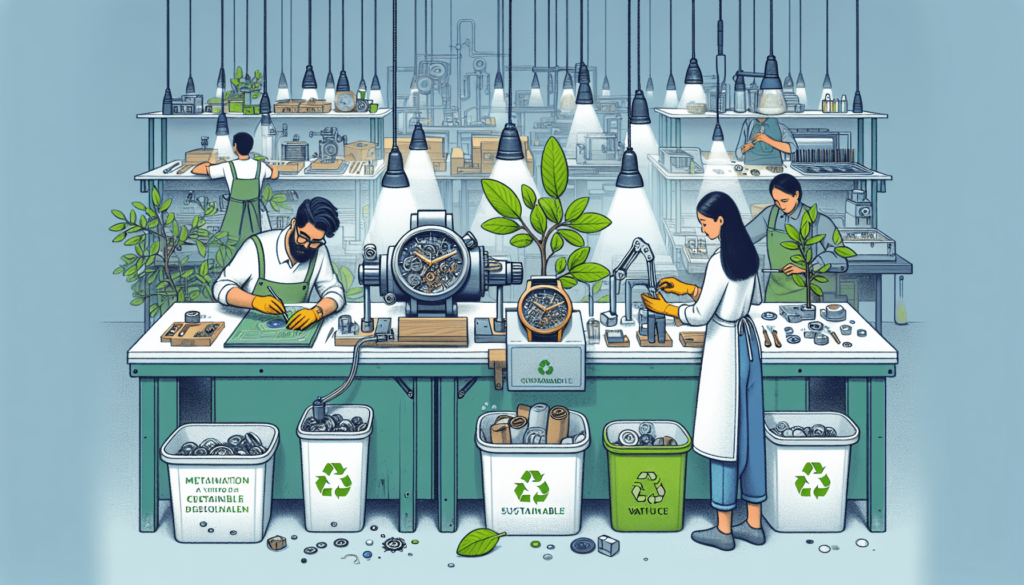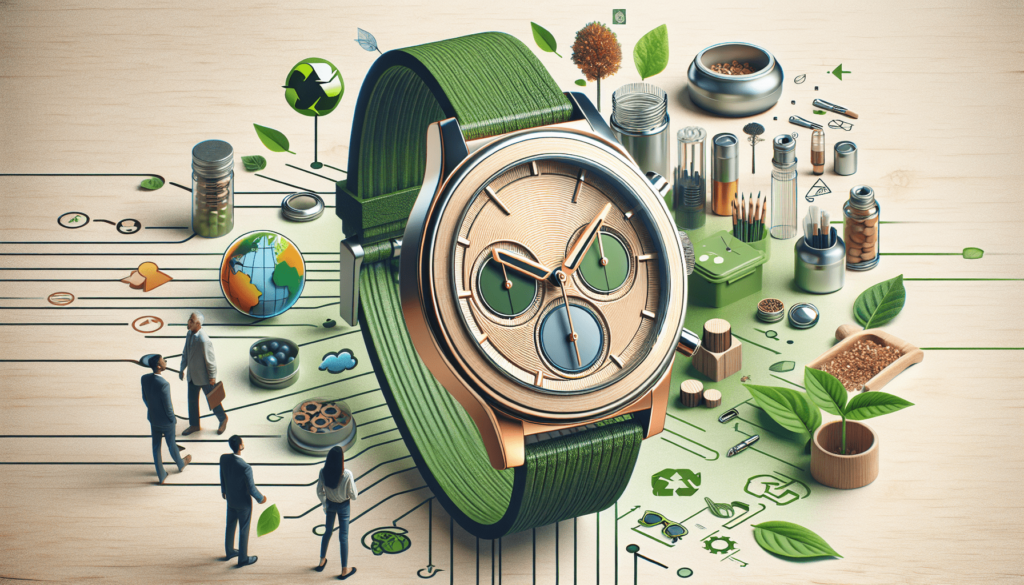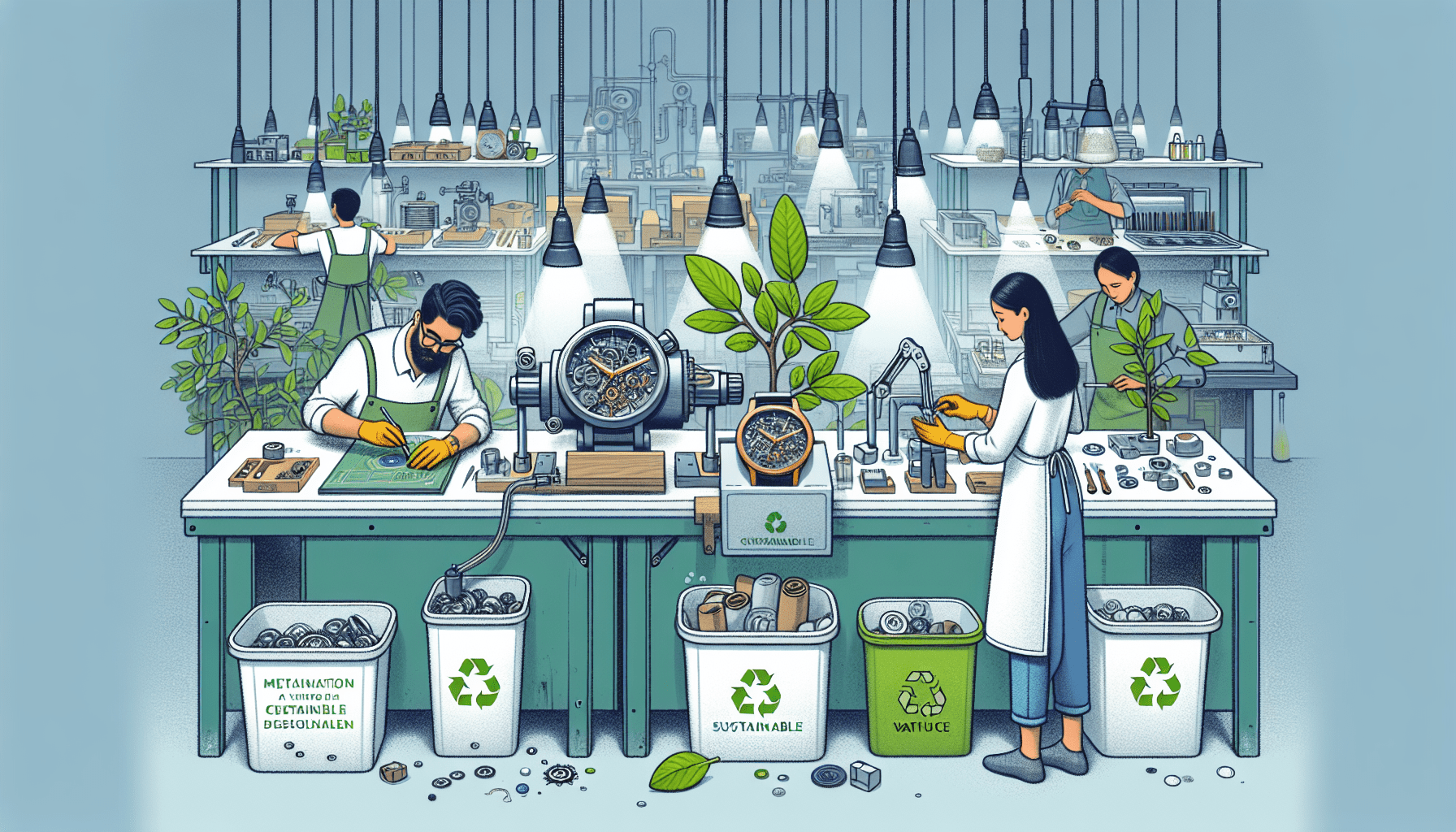In the ever-evolving world of watchmaking, a new revolution is underway: the use of biodegradable and recyclable materials. As our society becomes increasingly conscious of the environmental impact of our choices, the watch industry is stepping up to the challenge by exploring innovative alternatives to traditional materials. By embracing biodegradability and recyclability, watchmakers are not only reducing their carbon footprint but also opening up a realm of possibilities for sustainable and ethical timepieces. Join us as we delve into the exciting future of biodegradable and recyclable materials in the world of watchmaking, where style meets sustainability.
Introduction
Overview of biodegradable and recyclable materials in watchmaking
In recent years, the watchmaking industry has faced increasing scrutiny over its environmental impact and sustainability practices. As the world grapples with the effects of climate change and the urgent need to reduce our carbon footprint, industries of all kinds are exploring ways to adopt more eco-friendly practices. The use of biodegradable and recyclable materials in watchmaking has emerged as a promising solution to address the environmental challenges faced by the industry. This article will explore the current challenges, advantages, research and development efforts, case studies, potential future prospects, and the long-term benefits of biodegradable and recyclable materials in watchmaking.
Current challenges in watchmaking
Environmental impact of traditional materials
Traditional watchmaking materials, such as stainless steel, aluminium, and precious metals like gold and silver, have a significant environmental impact. The extraction of these materials often involves environmentally destructive mining practices, which can lead to deforestation, habitat destruction, and water pollution. Additionally, the manufacturing processes required to transform these raw materials into watch components result in greenhouse gas emissions and contribute to air and water pollution.
Limited availability of biodegradable and recyclable materials
Another challenge in incorporating biodegradable and recyclable materials in watchmaking is the limited availability of suitable options. While industries like fashion and packaging have made significant strides in utilizing eco-friendly materials, the watchmaking industry has been slower to adopt these alternatives. This is partly due to the unique technical requirements of watch components, such as durability and resistance to external elements like water and shocks. However, with advancements in material science and the increasing demand for sustainable products, new options are emerging.
Technological limitations
The integration of biodegradable and recyclable materials into watchmaking also faces technological limitations. Many of the materials traditionally used in watchmaking have been refined and perfected over centuries, making them challenging to replace. Watch components need to be precise, reliable, and resistant to wear and tear. Finding biodegradable and recyclable materials that can meet these requirements is a significant hurdle for researchers and manufacturers. However, with ongoing research and development efforts, promising advancements have been made.

Advantages of biodegradable and recyclable materials
Reduced environmental footprint
One of the most significant advantages of incorporating biodegradable and recyclable materials in watchmaking is the reduced environmental footprint. By replacing traditional materials with eco-friendly alternatives, the negative impacts associated with mining, manufacturing, and disposal can be minimized. Biodegradable materials break down naturally, while recyclable materials can be repurposed, reducing the need for new resources. This shift towards sustainability in the industry can contribute to a more responsible and environmentally conscious approach to watchmaking.
Improved sustainability
The use of biodegradable and recyclable materials in watchmaking can significantly improve the sustainability of the industry. Unlike traditional materials that contribute to resource depletion and create waste, sustainable materials have a closed-loop lifecycle. Bio-based materials, such as plant-derived polymers or bio-ceramics, offer the potential for renewable sourcing and reduced reliance on fossil fuels. This shift towards sustainable materials aligns with the global push for a circular economy and promotes the conservation of natural resources for future generations.
Bio-based materials and their benefits
Bio-based materials, derived from renewable sources like plants or microorganisms, have gained attention for their potential in watchmaking. For example, biopolymers made from corn or sugarcane offer a sustainable alternative to petroleum-based plastics used in watch straps or case components. These materials are biodegradable and reduce the industry’s reliance on fossil fuels. Similarly, bio-ceramics made from natural mineral sources offer high strength, scratch resistance, and aesthetic appeal, making them viable alternatives for watch cases and bezels.
Integration with existing watchmaking techniques
The successful implementation of biodegradable and recyclable materials in watchmaking requires their seamless integration into existing manufacturing techniques. Traditional craftsmanship and watchmaking expertise are highly valued, and any sustainable materials used must meet the demanding standards of precision and quality. Manufacturers are investing in research and development to understand how to work with sustainable materials, ensuring that the final product not only meets environmental standards but also upholds the time-honored traditions of watchmaking.
Research and development
Exploring new materials
Research and development efforts in watchmaking are pivotal in exploring new biodegradable and recyclable materials. Scientists and engineers are actively seeking innovative solutions, leveraging material science, and exploring the unique properties of eco-friendly alternatives. By analyzing the performance, durability, and environmental impact of these materials, researchers can identify the most suitable options for watch components.
Innovations in manufacturing processes
Alongside the discovery of new materials, innovations in manufacturing processes are necessary to incorporate biodegradable and recyclable materials effectively. Advanced manufacturing techniques, such as 3D printing or laser machining, can be adapted to work with sustainable materials, enabling precise and efficient production. By optimizing these processes, manufacturers can achieve higher levels of sustainability while meeting the technical requirements of the watchmaking industry.
Collaborations with other industries
Collaborations between the watchmaking industry and other sectors, such as materials science, fashion, and automotive industries, can bring valuable insights and expertise to the development of biodegradable and recyclable materials. Sharing knowledge and resources can accelerate progress and enable cross-industry innovations. By embracing collaboration, the watchmaking industry can tap into a wider range of sustainable material options and manufacturing techniques.
Testing and certification
To ensure the viability and reliability of biodegradable and recyclable materials, rigorous testing and certification processes are essential. These processes evaluate the materials’ performance under various conditions, including durability, water resistance, and their ability to withstand wear and tear. Testing and certification instill confidence in both manufacturers and consumers, assuring them that the sustainable materials used in watchmaking meet the required standards of quality and longevity.

Case studies
Brands and manufacturers using biodegradable and recyclable materials
Several forward-thinking brands and manufacturers have embraced the adoption of biodegradable and recyclable materials in their watchmaking processes. For example, Swedish watch brand TRIWA has incorporated recycled stainless steel and organic leather straps into their designs, reducing their environmental impact without compromising style or quality. Another notable brand is WeWOOD, which crafts watches from sustainably sourced wood, offering timepieces that are both fashionable and eco-friendly.
Successful implementation and consumer response
The implementation of biodegradable and recyclable materials in watchmaking has received positive feedback from consumers who are increasingly conscious about the environmental impact of their purchases. These sustainable alternatives align with the values of environmentally conscious consumers, attracting a niche but growing market segment. By offering eco-friendly options without sacrificing style or functionality, watch brands can resonate with this environmentally conscious consumer base and drive market growth.
Design and aesthetic considerations
One concern when considering biodegradable and recyclable materials in watchmaking is the impact on design and aesthetics. Traditional materials like stainless steel or precious metals have long been associated with luxury and timelessness. However, sustainable materials offer unique textures, colors, and organic appeal that can create innovative and visually striking designs. By embracing sustainable materials with thoughtful design, watchmakers can broaden their aesthetic horizons and attract consumers who value uniqueness and eco-consciousness.
Challenges and considerations
Durability and lifespan
One of the primary challenges in utilizing biodegradable and recyclable materials in watchmaking is ensuring their durability and lifespan. Watches are often subjected to harsh conditions, including water exposure, impact, and everyday wear. Sustainable materials must demonstrate the same level of resilience and longevity as their traditional counterparts. Extensive testing and ongoing quality control processes are crucial to ensure that these materials meet the industry’s demanding standards.
Cost and affordability
Another consideration is the cost and affordability of biodegradable and recyclable materials. Sustainable materials often require additional investments in research, development, and manufacturing processes, which can result in a higher price point for environmentally friendly watches. However, with advancements in technology and increasing market demand, economies of scale can reduce costs and make sustainable watches more accessible to a wider range of consumers.
Supply chain and sourcing
The sustainable use of biodegradable and recyclable materials in watchmaking necessitates a careful examination of the entire supply chain. From responsibly sourcing raw materials to ensuring ethical labor practices, watch brands must prioritize transparency and traceability. Collaboration with suppliers who align with sustainability principles is crucial to reduce the overall environmental impact and instill consumer trust.
Recycling and disposal processes
While biodegradable materials naturally break down over time, recyclable materials require a systematic approach to recycling and disposal. Watch manufacturers must establish efficient and reliable systems for recovering and reusing these materials at the end of their lifecycle. Collaboration with recycling and waste management industries is vital to close the loop and prevent these materials from ending up in landfills, contributing to the circular economy.
Future prospects
Emerging trends in sustainable watchmaking
The future of biodegradable and recyclable materials in watchmaking looks promising, with emerging trends pointing towards increasing adoption. Watch brands are embracing sustainability as a core value, and consumers are becoming more aware of the environmental impact of their purchases. This growing demand for sustainable products is driving the industry towards innovative solutions and environmentally responsible practices.
Technological advancements and innovations
Technological advancements are instrumental in pushing the boundaries of what is possible in sustainable watchmaking. From advancements in material science to manufacturing process innovations, technology plays a critical role in enabling the use of biodegradable and recyclable materials. As these technologies continue to evolve, the industry will have more options and capabilities to create sustainable timepieces with uncompromised quality.
Potential for mass adoption and market growth
As environmental awareness continues to grow, the potential for mass adoption of biodegradable and recyclable materials in watchmaking also increases. More and more consumers are actively seeking products that align with their sustainability values, creating a significant market for eco-friendly watches. With the right combination of attractive design, functionality, and eco-credentials, sustainable watches have the potential to capture a considerable market share and drive industry-wide growth.
Conclusion
Summarizing the potential of biodegradable and recyclable materials in watchmaking
The future of watchmaking lies in the adoption of biodegradable and recyclable materials. By addressing the current challenges in the industry and leveraging the advantages offered by sustainable materials, the watchmaking industry can reduce its environmental footprint and promote a more responsible and sustainable approach. Research and development efforts, collaborations, and testing and certification processes are essential in driving innovation and ensuring the viability of these materials.
Call to action for industry-wide adoption
For the watchmaking industry to fully embrace and benefit from the potential of biodegradable and recyclable materials, a collective effort is required. Industry players, from manufacturers and brands to suppliers and consumers, must prioritize sustainability and work together towards making sustainable watches the norm rather than the exception. By sharing knowledge, investing in research and development, and promoting eco-friendly options, the industry can drive positive change and pave the way for a more sustainable future.
Long-term benefits for the environment and sustainable practices
The adoption of biodegradable and recyclable materials in watchmaking carries significant long-term benefits for the environment and sustainable practices. By reducing reliance on traditional materials, the industry can contribute to the conservation of natural resources and minimize environmental damage caused by extraction and manufacturing processes. Additionally, the use of sustainable materials aligns with the global movement towards a circular economy, fostering a more responsible and sustainable approach to production and consumption.
By embracing the potential of biodegradable and recyclable materials, the watchmaking industry can become a trailblazer in sustainable practices, demonstrating that style and quality need not come at the expense of the environment. Through ongoing research, innovation, and industry-wide collaboration, the watchmaking industry can shape a future where timepieces not only captivate with their design and craftsmanship but also showcase a commitment to a greener and more sustainable planet.

